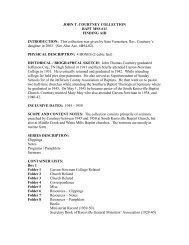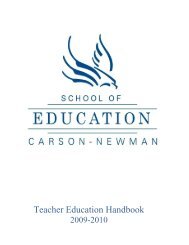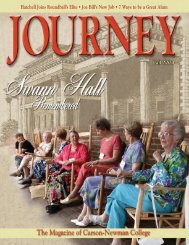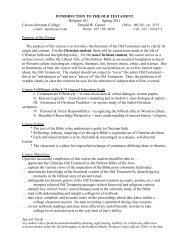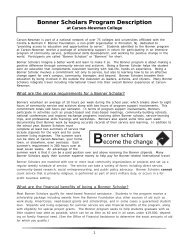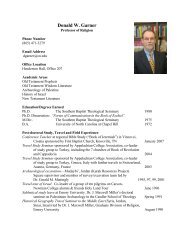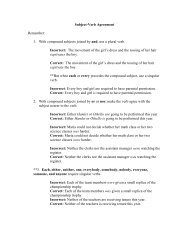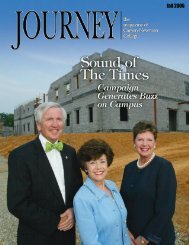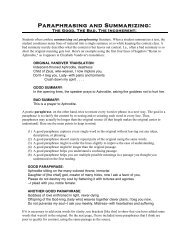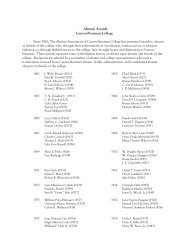Mestizaje As Revealed In The Dual Nature Of - Library - Carson ...
Mestizaje As Revealed In The Dual Nature Of - Library - Carson ...
Mestizaje As Revealed In The Dual Nature Of - Library - Carson ...
Create successful ePaper yourself
Turn your PDF publications into a flip-book with our unique Google optimized e-Paper software.
<strong>Mestizaje</strong> as <strong>Revealed</strong> in the <strong>Dual</strong> <strong>Nature</strong> of Oaxacan Wood Carvings<br />
an Honors Project submitted by<br />
Heather N. Smith<br />
a BA student in Professional Spanish and Cross-Cultural Sociology<br />
2792 Greer Rd.<br />
Goodlettsville, TN 37072<br />
615-429-3739<br />
Project Advisor: Dr. Maria Clark<br />
©2009 Heather Smith
Smith 2<br />
Outline<br />
I. <strong>In</strong>troduction<br />
II.<br />
History of Oaxacan wood carvings<br />
A. Impact of global economy on crafts in rural areas<br />
III.<br />
Cultural Foundations of Oaxaca and “Alebrijes”<br />
A. <strong>In</strong>digenous heritage of the state of Oaxaca<br />
B. Pre-Columbian influences<br />
C. Animal symbols<br />
D. <strong>The</strong> “Boom” and magical realism<br />
E. Nahualism<br />
IV.<br />
Oaxacan wood carving as a folk art<br />
A. Utility<br />
a. economic use in villages<br />
b. fabrication of practical items<br />
B. Community<br />
a. family participation<br />
C. <strong>In</strong>dividuality<br />
a. competitive drive for originality<br />
b. creative input, the evolution of style and the imagination<br />
D. Symbolism<br />
a. nature imagery and the ecological impact of woodcarving<br />
E. Conclusion
Smith 3<br />
Mexico is often seen as a collision of two worlds—indigenous customs overlapping with<br />
European beliefs—a mestizaje. Author Carlos Fuentes has referred to Mexico’s past as a “buried<br />
mirror” in which people of modern Mexico can see themselves by looking at the archaeological<br />
remnants left by ancestors. Archaeology has indeed revealed many figures from the world of<br />
ancient Mexico that may still exist in some hybrid form in the present culture. <strong>The</strong> wood<br />
carvings of Oaxaca encompass the entire spectrum of Mexican history, from the ties with Pre-<br />
Columbian Mesoamerica to the new cultural elements brought about by the Spanish conquest to<br />
the emergence of the Mexican nation into the global market during the twentieth century. <strong>The</strong><br />
figures that emerge in Oaxacan wood carving demonstrate the concept of mestizaje as people<br />
from rural Mexico carve out images that have found their way into the villagers’ lives through<br />
archaeological remnants and popular culture. Author Marjorie Agosín presents a poetic<br />
description of this relationship between the artist and his country as she discusses two of<br />
Mexico’s most recognized artists, “Frida Kahlo and Diego Rivera inserted the art of Europe into<br />
that of Mexico by focusing on the concept of a hybrid and transparent nation, at once<br />
sophisticated and innocent, steeped in its own violence. <strong>As</strong> artists, they invented themselves, but<br />
they also invented Mexico” (11). Kahlo and Rivera illustrate mestizaje by bearing a national art<br />
that recognizes the dual aspect of the country’s birth. <strong>The</strong> inclusion of a blue eyed, dark skinned<br />
baby in one of Rivera’s murals at the National Palace best represents this hybrid birth of the<br />
nation. This mestizaje reveals itself in the predominantly mestizo population and in a fusion of<br />
cultural elements.<br />
<strong>The</strong> artisans of the villages of Oaxaca are also a part of this story of a nation of dualities<br />
and sometimes paradoxes. <strong>The</strong> wood carvers of San Martín, Arrazola, and La Unión built a<br />
market out of local timber sources, basic knives, and inspiration, yet Oaxacan wood carving
Smith 4<br />
demonstrates the mestizaje of Mexico as much as the murals on the nation’s history that Diego<br />
Rivera implanted in the walls of the National Palace. Oaxacan wood carving captures the dual<br />
nature of Mexico through the antagonism between the popular art of the village and the<br />
economic drive of the global marketplace. <strong>The</strong> wood carvings depict native animals and<br />
historical figures as well as exotic creatures from the imagination of the artist. <strong>The</strong> carvers render<br />
this multitude of shapes and in doing so their figures become images that identify Mexico once<br />
they appear on the global market. Which Mexico? <strong>The</strong> Mexico of history textbooks? <strong>The</strong> Mexico<br />
that tourists perceive? <strong>The</strong> Mexico that the carvers experience from day to day? <strong>As</strong> Agosín tells<br />
us in regard to Kahlo and Rivera, it is the artists who define Mexico. <strong>The</strong> carvings come from the<br />
images that the carvers have in their minds, and the final forms become a part of a definition of<br />
Mexico that is based on the experiences of the individuals that compose the country. Much<br />
critical attention has been given to the impact of the global market on rural villages that produce<br />
folk art, but the market is not the ultimate deciding factor on carvings produced in Oaxaca.<br />
Néstor García Canclini 1 discusses the importance of a two-fold view of communal craft<br />
products:<br />
We do not get a total picture of what is happening with crafts if we<br />
consider the situation that currently confronts them one-way, from the perspective<br />
of capitalism alone. Artisanal goods have also been, for many centuries, cultural<br />
and economic expressions of <strong>In</strong>dian groups. This double enrollment—historical<br />
(in a process that stems from pre-Columbian societies) and structural (in the<br />
contemporary logic of dependent capitalism)—gives rise to their hybrid nature.<br />
<strong>The</strong> analysis of this hybrid nature must travel a road between two precipices: the<br />
1 Argentine-born author Néstor García Canclini’s publications include Hybrid Cultures (1995) and other works on<br />
the implications of mixed culture in Latin America.
Smith 5<br />
folklorist temptation to see only the ethnic aspect and consider crafts as merely<br />
fading remnants of dying cultures; or, as a backlash, the danger of isolating an<br />
economic interpretation and studying them as one would any other item ruled by<br />
the logic of the market (45).<br />
This study of Oaxacan wood carving will examine the carvings in a dual manner. <strong>The</strong> economic<br />
trends in folk art and the carving villages have been a popular focus of study in an age that<br />
concerns itself with fair trade and sustainable livelihoods for rural people and their cultures, but<br />
the cultural and artistic background of the carvings should not be denied or ignored. I will<br />
examine the ways in which the artists express themselves and depict various aspects of their<br />
culture to arrive at a more holistic understanding of Oaxacan wood carvings as they relate to<br />
broader concepts of Mexican history by validating the cultural and artistic qualities present in the<br />
craft.<br />
My interest in Oaxacan woodcarvings began when I was at Disney’s Epcot in 2006. A<br />
woman was painting brightly colored animal figures that had been carved in Oaxaca, one of<br />
Mexico’s southernmost states. I purchased an armadillo and upon returning home to Tennessee, I<br />
was surprised to find similar carvings being sold in the Smoky Mountains. I began to wonder<br />
why these allegedly traditional pieces of Mexican folk art were of so much interest to American<br />
buyers. Despite what American buyers might think, the carvings are not a traditional Mexican<br />
folk art at all but were developed by a mestizo man in the 1960s during economic difficulties in<br />
Mexico. North American buyers may assume that the carvings are related to indigenous cultures<br />
of the Oaxaca region, but the original creator of the carvings is not indigenous just as the patterns<br />
painted on the carvings are not always traditional styles. While collectors and wholesalers<br />
generally refer to the carvings as “alebrijes”, the term is actually an inappropriate application. It
Smith 6<br />
came from a popular papier-mâché artist, Pedro Linares, from Mexico City and was applied to<br />
the carvings due to the recognizable aspect of the term and the fanciful animal shapes present in<br />
both art forms.<br />
What are today referred to as “alebrijes” or Oaxacan wood carvings, were born of the<br />
inspiration of Manuel Jiménez, a mestizo man who worked in masonry and agriculture until his<br />
carvings received significant attention. Carving had been done in the form of ox carts, festival<br />
masks, and children’s toys to some extent, but the popular “alebrije” form of today was<br />
unknown. Manuel Jiménez hails from Arrazola, a village southwest of the Oaxacan state capital.<br />
Anthropologist Michael Chibnik, a premier authority on Oaxacan wood carving 2 , notes that<br />
Jiménez is recognized as the original creator who believes all other carvers to be unoriginal<br />
copiers (Crafting Tradition 19). Jiménez selected a local wood known as copal that grows in a<br />
twisted manner, is soft enough for carving, and sands smoothly. Carvers often select pieces of<br />
wood with particular curves that may be suitable for an animal shape; a branch with a curl like a<br />
tail may be formed into an iguana, for example. Painting was originally done with aniline dyes<br />
but in the 1980s most artists converted to acrylic house paints (40). <strong>The</strong> decoration of the<br />
carvings sometimes includes real animal hair, corn husks, and ixtle fibers (40). Other carving<br />
villages have developed in San Martín Tilcajete south of Oaxaca with Isidoro Cruz as a leading<br />
carver and La Unión Tejalapan west of Oaxaca headed by Martín Santiago. <strong>In</strong> the 1970s,<br />
government agencies also encouraged craft sales in order to improve the economy; in fact,<br />
Isidoro Cruz began selling his carvings after contact with and encouragement from the National<br />
Council of Expositions, a government organization pushing crafts for the tourist market in search<br />
of economic stimulation for the country (Market Niches 229). <strong>The</strong> pioneers of “alebrije” carving<br />
2 Chibnik’s most extensive writing on Oaxacan wood carving is entitled, Crafting Tradition: <strong>The</strong> Making and<br />
Marketing of Oaxacan Wood Carvings (2003). <strong>The</strong> book predominantly focuses on the economic aspects of the<br />
craft.
Smith 7<br />
made way for drastic transformation in the villages as a wood carving boom began in the mid<br />
1980s (Crafting Tradition 35). Though it is still difficult to travel to the villages of Arrazola, San<br />
Martín, and La Unión due to their rural settings, the economic impact has improved the lives of<br />
many villagers. Entire families often participate in the production process with men cutting the<br />
shape out of copal or pine wood, children and the elderly sanding the pieces and women painting<br />
them (Barbash 40). Despite the fact that the villages engage with a global market for economic<br />
stability, they still retain communal qualities of a pre-industrial society; for example, all family<br />
members contribute equally to the financial well-being of the family, and the extended family<br />
participates in the process as opposed to a mobile nuclear family in which one family member<br />
works outside the home to provide financial support.<br />
While the carving villages retain the communal elements that characterize traditional folk<br />
art production, the craft has also become more commercial through the extension to a global<br />
market and the inclusion of large workshops that produce the carvings. <strong>The</strong> commercialization of<br />
folk art leads to questions concerning the original artistic value of “alebrijes” due to the<br />
economic dependency some families have on the craft. <strong>In</strong> his study “Market Niches in Oaxacan<br />
Woodcarving,” Chibnik states, “Merchants have learned that tourists are also willing to buy<br />
“folk” artisanry that does not have long-standing cultural significance. Pre-Columbian motifs<br />
appear on pottery, jewelry, and wallets. Skirts, jackets and blouses made of local textiles bear<br />
patterns invented in the twentieth century” (228). Appearing in the mid 1960s, Oaxacan wood<br />
carvings seemingly lack a long heritage. <strong>The</strong> painters develop individual styles that appeal to<br />
buyers often because the latter may presume the figure to be painted in an indigenous motif;<br />
thus, the market dictates the styles of carvings. <strong>As</strong> Chibnik points out, superior artists can be<br />
more experimental with their creations and take the time to produce more elaborate figures for
Smith 8<br />
collectors (235). <strong>In</strong>dividuals who rely on the craft for income do not have the luxury of<br />
experimenting with unique pieces because they need the product to be stable for profit. Shapes<br />
and paint styles that readily sell are continually reproduced and may lose originality even though<br />
each individual carving is handcrafted. Carvers who are artistically superior also compete with<br />
the more commercial artists because pieces that sell well or pieces that have been popularized by<br />
advertisement are quickly imitated for the tourist market in its search for cultural relics.<br />
<strong>The</strong> presence of magical or fantastic elements in everyday life is one facet of Mexican<br />
culture that foreign buyers may look for in the carvings. According to internet sites such as El<br />
Caracol Zapoteca and Port Wahakaa that make carvings available for purchase with descriptions<br />
of the particular carver’s specialties and each carving’s uniqueness, the “alebrijes” contain spirits<br />
from the trees. Perhaps such legends are the origin of journalist Shepard Barbash’s book on the<br />
whimsy of the carvings entitled <strong>The</strong> Magic in the Trees. <strong>The</strong> difficulty comes in knowing<br />
whether these stories are merely inventions to give the craft some sale-promoting substance. On<br />
a trip to a border town I observed a selection of “alebrijes” in a gift shop and noticed that the<br />
brightly colored figures appealed to many tourists passing by the display. Above the showcase a<br />
poster highlighted various symbolic interpretations of the carvings, such as “the flat feet<br />
represent our connection to the earth.” On the contrary, my research has not indicated that this<br />
specific form of symbolism exists in the carvings or in the beliefs of the carvers. Many of the<br />
stories and pieces of information supplied to buyers are merely for the purpose of creating a<br />
deeper significance behind the “alebrijes.” However, many of the carvers of San Martín claim a<br />
Zapotec heritage, and the Zapotecs did have certain symbolic elements that parallel the carvings.<br />
Joyce Marcus describes Pre-Columbian Zapotec religion:
Smith 9<br />
Perhaps the most crucial concept in Zapotec religion was that of pe (written pee in<br />
the sixteenth century, pronounced be by today's Zapotec). Variously translated as<br />
'wind', 'breath' or 'spirit', pe was the vital force that made all living things move.<br />
Anything that moved was thus alive, to some degree sacred, and deserving of<br />
respect: animals, human beings, clouds, lightning, earthquakes, the 260-day ritual<br />
calendar and the foam on the top of a cup of stirred hot chocolate are examples of<br />
things which possessed pe. (174)<br />
While the Pre-Columbian Zapotecs had a concept of a Supreme Being, their religion also<br />
retained an animistic quality like that present in many early hunter-gather societies. This data on<br />
the historical religious perspective of the Zapotecs gives credibility to stories of spirits within the<br />
trees that manifest themselves in the carved figures. <strong>In</strong> addition, carver Vicente Hernádez<br />
Váquez further confirms the stories with the idea that the figures are “magical” 3 (interview).<br />
Traditional festivals also place the woodcarvings in a better understood social and<br />
historical context. Villages organize festivals and fiestas throughout the year for everything from<br />
religious commemoration to rites of passage. Many times the carvings reflect these social<br />
customs and religious traditions through figures representing mariachis and saints. <strong>The</strong>refore, it<br />
is challenging to determine if instrument playing frogs have been modeled to intrigue tourists or<br />
if these whimsical figures are an extension of an elaborate cultural heritage of celebrations since<br />
many of the well-known carvers of “alebrijes,” including Manuel Jiménez, were involved in<br />
carving festival masks prior to the wood carving boom.<br />
3 It is difficult to determine what is meant by “magical” as Vicente Hernández Vásquez only replied “Yes, magical”<br />
without elaboration when asked if he considered the pieces to be magical. His response may have been for the<br />
appeasement of the interviewer as he also said that foreign buyers sometimes come in and say “Oh, this looks like<br />
a…” to which he replies “Okay.” Further, though the carvers accept notions of the magical in the everyday, the<br />
carvers are generally unfamiliar with terms such as magical realism that are discussed in the academic world.
Smith 10<br />
Many craft forms in Mexico experience problems with their authenticity as a folk art and<br />
lack a long-standing communal heritage. Zapotec weavings are marketed as a product that has<br />
been fabricated unchanged since the arrival of sheep in the Americas during the16 th century in<br />
order to give the craft the appeal that it stems from the days before capitalism and mass<br />
production (Stephen 23). Sellers of “alebrijes” also play off the simplistic features of the craft as<br />
a way of marketing in a world of competitiveness and cheap goods. Paradoxically, artisans that<br />
sell items such as weavings, pottery or “alebrijes” become increasingly dissociated from them as<br />
they participate in the global market. Néstor García Canclini describes this irony in relation to<br />
the everyday dress of rural and indigenous people:<br />
On the one hand, <strong>In</strong>dian made clothes and household items are worn and used less<br />
and less in peasant societies since they are being replaced by manufactured goods<br />
that are cheaper and more attractive because of their design and modern<br />
connotations. But the declining artisanal production is revived thanks to a<br />
growing demand for exotic objects in the country’s cities and abroad. (41)<br />
While tourists purchase goods from rural areas because of their seeming disconnection with the<br />
complications of the industrial world, artisans from rural areas simultaneously idolize the<br />
attractiveness of urban society that tourists transport into their villages. <strong>In</strong> the case of some<br />
traditional folk arts, the everyday importance of the objects and their local cultural value is<br />
increasingly overshadowed by the appeal of profits. David Carruthers 4 describes the appeal of the<br />
folk art of these villages for outsiders: “<strong>In</strong> a machine-manufactured world of reliable uniformity,<br />
handmade indigenous arts and crafts offer a refreshing antidote to the grinding homogenization<br />
4 David Carruthers is a Political Science professor with research interests in environmental justice in Latin America.<br />
Carruthers’ publications on the conflict between global economic forces and traditional village lifestyles include<br />
“Mapuche Protest, Environmental Conflict, and Social Movement Linkage in Chile (2008),” Environmental Justice<br />
in Latin America: Problems, Promise, and Practice (2007), and “<strong>The</strong> Globalization of Environmental Justice:<br />
Lessons from the US-Mexico Border (2008).”
Smith 11<br />
and standardization of corporate capitalism” (4). <strong>The</strong> rationalized locales that promote<br />
consumption in an urban society supply the appeal of folk art as people search for commodities<br />
that break from the uniformity of goods from the industrial sector. <strong>The</strong> popularity of Oaxacan<br />
wood carvings may be attributed to this break from the corporate world since carvers still<br />
produce them by hand.<br />
Despite the economic implications of the woodcarving boom, I believe the cultural<br />
background of the artists is an undeniable and important influence on the products. Ox-carts and<br />
festival masks have a long-standing carving heritage and some of the carvers of “alebrijes”<br />
worked in these traditions prior to the wood-carving boom. However, one must distinguish<br />
between fabricated claims of cultural significance and authenticity and genuine links to Pre-<br />
Columbian artistic expression and underlying belief systems.<br />
Oaxaca is a state in Mexico with an enduring and vibrant indigenous population. Around<br />
350,000 Zapotecs, Mixtecs, and Nahuas inhabited the Valley of Oaxaca before the Spanish<br />
conquest (Chance 607). Remnants of these groups remain in Oaxaca even today, though in a<br />
hybridized form. <strong>The</strong> first factor relating to the modification in these groups is the mestizaje<br />
brought about by the influx of Spaniards in the 16 th century. A group designated as the naborías<br />
worked for the Spanish in jobs relating to artisanship, public works, and household service,<br />
placing a sector of the indigenous population in continual contact with the Spanish conquerors<br />
(610). <strong>As</strong> early as the Colonial Period, the value of the skills of the various indigenous groups<br />
was recognized as beneficial to communal progress; thus, the diverse indigenous populations<br />
became more interspersed in urban Spanish society. Marriage records reveal, however, that the<br />
<strong>In</strong>dian population in colonial Oaxaca was more inclined to marry within its ethnic group (623).<br />
Whether this inclination relates to class hierarchy or indigenous intent to preserve culture, this
Smith 12<br />
fact may account for the high visibility of indigenous groups in Oaxaca today. Despite a strong<br />
organization according to ethnic groups in southern Mexico, religious iconography, community<br />
organization, and linguistic classifications are all sectors of a social structure that were altered in<br />
some way by the interchange of Spanish and varied indigenous customs. Professor John K.<br />
Chance describes the situation of mestizaje in colonial Oaxaca:<br />
Despite the many differences separating <strong>In</strong>dians from other members of society,<br />
<strong>In</strong>dians often attended the same churches, held the same jobs, and worked in the<br />
same shops as non-<strong>In</strong>dians. <strong>The</strong>y formed an integral part of the urban milieu,<br />
though in a decidedly inferior position and without them the city would have<br />
been unable to function. (623)<br />
<strong>The</strong> ethnic and linguistic distinctions that remained stronger in Oaxaca than elsewhere in Mexico<br />
have been narrowed by the use of the term “indigenous” to refer to any number of <strong>In</strong>dian people<br />
from the region; most people, particularly outsiders, cannot distinguish between the groups. <strong>In</strong> a<br />
primarily mestizo nation, the use of the term “indigenous” often connotes ignorance,<br />
backwardness and a rejection of modern progress. Thus, one may exalt the sophistication of the<br />
ancient Maya or Aztec people yet deny one’s own indigenous heritage. At the same time, the<br />
widespread artisan ability characteristic of indigenous cultures is interpreted as Mexican culture<br />
and packaged for marketing to tourists. <strong>The</strong> curious case for Oaxaca wood carvings in the 20 th<br />
century is that they are not a traditional craft of <strong>In</strong>dian artisans but rather were developed by a<br />
mestizo man.<br />
Despite the non-indigenous foundations of Oaxacan wood carving, indigenous patterns<br />
and symbols are often incorporated into the designs of the “alebrijes.” People who produce folk<br />
art objects often sell them at sites of Pre-Columbian culture like the Zócalo of Mexico City, the
Smith 13<br />
pyramids of Teotihuacán, and the Zapotec pyramids of Monte Albán and Mitla in Oaxaca. Mitla<br />
is well-known for its carved geometric designs that distinguish it from other pyramids in Mexico<br />
with hieroglyphs. Zapotec symbols and designs like those found on the pyramid at Mitla are<br />
sometimes integrated into the folk art of Oaxaca including regional pottery and “alebrijes.”<br />
Fig. 1<br />
“Cantaro con Grecas” by Alba León Cantón. Personal photograph. 31 May 2008.<br />
Close to the carving village of San Martín Tilcajete is San Bartolo Coyotepec, which is known<br />
for its black colored pottery, and is also the location of the Museum of Popular Art of the State of<br />
Oaxaca. <strong>The</strong> majority of the museum’s collection consists of black pottery, ceramic sculptures<br />
and wood carvings. Traditionally, pottery has a more utilitarian purpose, but in San Bartolo<br />
Coyotepec it surpasses the daily object and falls into the realm of the artistic. Alba Leon Cantón<br />
captures the style of the Mitla pyramid that is also interpreted on wood carvings through the use<br />
of repeated geometric forms (see fig. 1). <strong>The</strong>se decorative symbols at Mitla contrast with
Smith 14<br />
pictographic images included on the pyramids of the Aztecs and the Mayas, and the artists of<br />
Oaxaca, including the wood carvers, incorporate this unique regional style into their art forms.<br />
<strong>The</strong> influence of Pre-Colombian cultures is still evident not only in the visual presence of<br />
pyramids that project from the landscape throughout Mexico, but also in elements of culture.<br />
Thus, the traditional style flower-embroidered dress from the region is comparable to the dress<br />
portrayed in the carving of an indigenous woman by Melchor Calvo (see fig. 2 and fig. 3).<br />
Fig. 2<br />
Hand stitched blouse of the Itsmo region, Personal photograph. 31 May 2008.
Smith 15<br />
Fig. 3<br />
“Istmena” by Melchor Calvo. Personal photograph. 31 May 2008.<br />
<strong>The</strong> attire portrayed by Calvo actually represents the traditional dress for the event of<br />
mayordomía, a sponsorship that individuals pay to host a celebration for a local saint. This<br />
festival contains elements of mestizaje as Catholic religious practices utilize traditional folk art<br />
of the region for its practice. Although “alebrije” carving is not traditionally an indigenous craft,<br />
the highly visible indigenous population of Oaxaca is nonetheless a subject for the carvers. <strong>The</strong><br />
artist realistically renders the characteristics of the figure from this occasion and also captures the<br />
detail of the floral designs present in traditional Oaxacan clothing. This inclusion of indigenous<br />
elements in a non-indigenous craft also expresses mestizaje as the carvers adopt a variety of<br />
cultural elements for their carvings. Furthermore, the representation of more culturally<br />
significant figures creates a sense of pride for their creators, and these figures may be displayed<br />
in the home of the carver rather than sold as Jacobo Ángeles exemplifies here with his carved<br />
interpretation of the matlazigua.
Smith 16<br />
Fig. 4<br />
“Encuentro de la Matlazigua y Pedro” by Jacobo and María Ángeles. Personal photograph. 31 May, 2008.<br />
<strong>The</strong> matlazigua is an element of cultural folklore regarding a perfect, elusive woman that appears<br />
as a temptation for men. <strong>As</strong> a form of mestizaje, the tale mixes the reality of temptation with a<br />
folkloric icon. Jacobo Ángeles worked with his wife, María, to complete this multi-component<br />
carving which they display in their home in San Martín (see fig.4).<br />
Another cultural element depicted in the wood carvings are the faunas of Mesoamerica.<br />
Historically, such carvings have a long and enduring presence in the art of Mexico. Guilhelm<br />
Olivier writes, “<strong>The</strong> omnipresence of the animal world in the daily life and the cosmovision of<br />
the people of Mesoamerica appear in abundant and varied testimonies of archaeological, plastic,<br />
iconographic, and literary character” 5 (5). <strong>The</strong> dog is one such symbol in Mexico that was of<br />
importance to Mesoamerican cultures and that still roams the streets throughout Mexico. It is<br />
believed to have appeared in the geographical area of modern day Mexico around 8000 years<br />
ago, making it the first domesticated animal in Mexico (Azua 34). It had continual importance in<br />
various Mesoamerican civilizations, as evidenced in the discovery of dogs in tombs as a guide<br />
5 Translation mine
Smith 17<br />
into the world of the dead (Olivier 6; Garza 28). Accompanying this ritual importance of dogs is<br />
the symbolic position the dog held in Mesoamerica as a representation of Xólotl, the twin brother<br />
of the god Quetzalcoatl. Further, the dog was sometimes used in ritual sacrifice and also appears<br />
on the ritual calendar of the Nahuas and Mayas (Garza 30). <strong>The</strong> importance of animals, and<br />
specifically the dog, presents itself in various Pre-Columbian civilizations. <strong>The</strong> interaction of the<br />
human inhabitants of the region with the fauna of the area leads to their representation in the<br />
culture and integration into the sacred.<br />
Today, contact between the animals and people of Mexico still leads to the reflection of<br />
the people on their surroundings. While the dog is no longer considered sacred in Mexican<br />
culture as it was in Pre-Columbian times, artistic representations prevail. One of the first shapes<br />
to appear in Oaxacan carving is the dog (see fig. 5). Collectors sometimes classify these early<br />
“alebrijes” as rustic due to more harshly cut lines, the attachment of parts with nails and modest<br />
painting that characterizes these carvings. <strong>The</strong> early carvings of dogs not only display the<br />
continued popularity of the dog as a key figure in Mexican culture, but also an evolution in the<br />
style of the carvings from the rustic form to a more stylized shape.<br />
Fig. 5<br />
Rustic style dog. Personal photograph by author. 31 May 2008.
Smith 18<br />
Fig. 6<br />
“Perro Flaco” by Narcisco González Ramírez. Personal photograph by author. 31 May 2008.<br />
Narcisco González Ramírez’s carving of a gaunt dog reveals a progression in style in Oaxacan<br />
carvings as the more recent figures are fluid, emerge from a solid piece of wood, and contain<br />
brightly colored paint schemes (see fig. 6). Further, the carving can be interpreted as a portrayal<br />
of the dog that exposes its degraded position in modern Mexican society due to overpopulation.<br />
Dogs roam the streets of modern Mexico, often undernourished or ill; the carving nonetheless<br />
indicates that the dog is still a cultural icon. <strong>In</strong>deed, the dog also encapsulates the notion of<br />
mestizaje, as is evidenced in the cat-like ears and tail of the carving that indicate the mixture of<br />
breeds.<br />
Animals, in general, are a commonly utilized subject for the carvings just as they are<br />
visible subjects in Pre-Columbian cave paintings in Southern Mexico. <strong>The</strong> hummingbird, the<br />
jaguar, and the grasshopper are among these animals that were present in Pre-Colombian art<br />
figures and that also appear in today’s Oaxacan carvings. <strong>The</strong> jaguar appears in Mesoamerican
Smith 19<br />
cultures as a figure for various gods and is often represented by sculptures, including at the<br />
pyramid of Monte Albán in Oaxaca (National Museum of Anthropology). According to carver<br />
Vicente Hernández Vásquez of San Martín Tilcajete, the jaguar continues to be a symbol of<br />
strength and sacredness (interview).<br />
<strong>The</strong> hummingbird appears on Mixteca pottery as yet another being from the animal world<br />
that is integrated into the visual art of the people (see fig.7). Archaeologists consider the “Copa<br />
Fig. 7<br />
Pacheco, Marco Antonio. Copa con colibrí. National Museum of Anthropology. Arqueología Mexicana. 6. 35<br />
(Jan-Feb1999): 12.<br />
con colibrí” a highpoint in Mixteca art as the bird sits on the cup poised to drink (National<br />
Museum of Anthropology). Generally, highly decorated pieces of pottery or sculpture are<br />
indicative of their more sacred value in Pre-Columbian culture. <strong>The</strong> “alebrije” hummingbird<br />
shares some stylistic features with the Mixteca hummingbird that give the two a shared
Smith 20<br />
appearance (see fig. 8). Though the Oaxacan carving has no ritual intent, the artist produces a<br />
piece with similar details.<br />
Fig. 8<br />
Hummingbird. Personal photograph by author. 31 May 2008.<br />
While many of the figures formed by Oaxacan artisans are pulled from images of their<br />
own culture, the imagination and the wider world are also influential on the shapes that come out<br />
of the carving villages. Like the cultural mestizaje resulting from Spanish conquest of indigenous<br />
populations, globalization results in an overlay of world images into the more traditional and<br />
native figures depicted by the carvings. Carvings of animals from the African savannah are often<br />
found amidst carvings of the typical fauna of Mexico, demonstrating the influx of images from<br />
abroad into the minds and imaginations of the carvers. Perhaps these new creative expressions<br />
based on images from abroad are just another way for the carvers to interpret the exoticness and<br />
whimsy of the world, and, in particular, its animals.
Smith 21<br />
Fig. 9<br />
Zebra by Eleazar Morales. Personal photograph. 4 Feb. 2009.<br />
Carver Eleazar Morales incorporates personal creative elements with the painting of zebras<br />
within zebra stripes (see fig. 9). While the stripe colors are realistic, the color of the animal’s<br />
mane is changed into something more fanciful. <strong>In</strong> this way, the carver takes liberty to depict a<br />
non-native animal.<br />
Just as the carvers’ attention is currently being directed toward different parts of the globe<br />
for inspiration, the completion of a successful Cuban Revolution in 1958 attuned the attention of<br />
the world to the affairs of Latin America and the Caribbean. This event can be viewed as a<br />
starting point for the “Boom” in Latin America (Rodríguez 847). <strong>The</strong> “Boom” is primarily<br />
viewed as a literary movement, during which time the translation of many Spanish works into<br />
various languages occurred. Nonetheless, the interest of foreigners in the political and cultural<br />
events of Latin America and the Caribbean throughout the decades of the 1960s and 1970s spans<br />
beyond just the literary. An apex of the “Boom” occurred when Guatemalan author Miguel<br />
Ángel <strong>As</strong>turias received the Nobel Prize for Literature in 1967, precisely at the time “alebrije”<br />
carving was emerging in Oaxaca. <strong>In</strong> particular, <strong>As</strong>turias’ 1949 novel Hombres de Maiz deals
Smith 22<br />
with the conflict between the “organic” indigenous world and the rational, commercial world that<br />
destructively intrudes in it (Franco 310).While the correlation with <strong>As</strong>turias’ Nobel Prize is<br />
intended to show the emergence of Oaxacan wood carvings on the world market during a period<br />
in which Latin American artists began receiving world recognition, it is also interesting to note<br />
that <strong>As</strong>turias’ writings engage the hybrid nature of Hispanic culture.<br />
“Alebrijes” connect with the important development of magical realism that transpired<br />
during the period of the “Boom.” Magical realism is considered an invention in which writers<br />
severed ties with strictly Eurocentric ideas of reality in order to present the clash between a<br />
rational and spiritual world present in their own culture (847). <strong>The</strong> term is applied to literature as<br />
well as visual arts. Jeffrey Weschler describes the genre from the perspective of painting,<br />
“Magical realism affords a surprising latitude of psychological effects, although it is pinned in,<br />
as it were, between realism and Surrealism” (294). <strong>The</strong> difficulty in defining magical realism<br />
relates to a structure that includes an element that is not entirely part of the rational world and at<br />
the same time does not belong entirely to the realm of the psychological or the subconscious of<br />
dreams. Rather, the break with reason can be associated with the indigenous heritage throughout<br />
Latin America and its supernatural and superstitious elements. A rejection of reason as it is<br />
defined by the Western world encapsulates the cosmology of much of Latin America. Latin<br />
American cultures break with the rationalization of the Western world, allowing the magical to<br />
occur in the everyday world. <strong>In</strong>terestingly, this literary and artistic genre relates to the much<br />
broader notion of mestizaje in which the rationalistic European model and the variety of<br />
indigenous beliefs combine to form a layered and multifaceted reality throughout Latin America.<br />
<strong>The</strong> spiritual world is generally seen as integrated into Mexican culture as a vibrant tradition that<br />
has continually coexisted with Western institutions since the European conquest of the Pre-
Smith 23<br />
Columbian civilizations. By incorporating non-realistic elements into “alebrijes,” Oaxacan wood<br />
carvers seem to integrate the widely recognized genre of magical realism into the essence of the<br />
carvings.<br />
<strong>In</strong> addition to magical realism, the carvings include other distinct Latin American<br />
features. <strong>The</strong> symbolism and supernatural that is an important part of the indigenous worldview<br />
finds its way into the carvings in the specific form of nahualism. Alessandro Lupo describes the<br />
continued presence of this concept:<br />
Between the numerous and varied examples offered with respect to the<br />
Mesoamerican people, the concepts conventionally denoted as nahualism and<br />
tonalism constitute a peculiar case, that even today they are found amply<br />
dispersed in the indigenous populations of Mexico and Guatemala, insomuch as<br />
their origins date back to the great civilizations of the Pre-Hispanic era 6 (17).<br />
<strong>The</strong> term nahualism refers to the supernatural ability of some people to take on a particular<br />
animal form, whereas the term tonalism deals with the concept of each person being born with an<br />
alter ego in the form of an animal. <strong>The</strong>se concepts, present in an informal structure in<br />
Mesoamerica prior to Spanish arrival, were not extinguished by the conquest. Rather, they<br />
become factors of the mestizaje. Fransico Rojas González projects that the birth of nahualism<br />
coincides with the time of Spanish conquest (364). That is to say that nahualism emerged as a<br />
product of the mestizaje. Early civilizations in Mesoamerica had the characteristic of animism.<br />
Upon the arrival of the Spanish conquistadores and monks, Christian religious iconography and<br />
symbols mixed with the religious background of the indigenous groups, giving birth to a new<br />
hybrid religious culture that is still alive in modern Latin America; nahualism is one such facet of<br />
this mix. <strong>The</strong> acceptance of the thin veil between the human world and the supernatural world of<br />
6 Translation mine
Smith 24<br />
animal spirits and gods was not only accepted by Pre-Columbian peoples who inhabited Mexico<br />
but was revitalized and transformed into the concept of nahualism portrayed by carver Manuel<br />
Jiménez in the twentieth century (see fig. 10 and fig. 11). <strong>The</strong> nahual depicted by Jiménez is a<br />
Fig. 10<br />
Pacheco, Marco Antonio. Vase with the form of a dog and the face of a man. National Museum of<br />
Anthropology. Arqueología Mexicana. 6. 35 (Jan-Feb1999): 28.<br />
Fig. 11<br />
“Nahual” by Manuel Jiménez. Personal photograph. 31 May 2008.
Smith 25<br />
less realistic subject for a wood carving; some of Jiménez’s early and more famous carvings<br />
include unpainted dogs and cross-legged frogs. Nahualism and other supernatural concepts are<br />
well-known by Mexican people, and Jiménez transfers this idea into a physical form. While the<br />
concept of nahualism does not originate with Jiménez, he creates his own interpretation through<br />
wood carving.<br />
Wood carvers like Jiménez transfer cultural concepts and images into a physical object<br />
via artistic interpretation. While “alebrije” carving is not a traditional or long-standing craft, the<br />
carvings themselves suggest the influence of an older culture on the product. <strong>Mestizaje</strong> evidences<br />
itself in the steady inclusion of Pre-Columbian motifs in a modern folk art, the carving of longstanding<br />
cultural symbols such as animals along with new images from abroad, and the<br />
continued blending of Western and indigenous cultures depicted by the carvings. <strong>The</strong> ongoing<br />
hybridization of Mexican culture confirms itself in the carvings and also serves to validate the<br />
cultural significance of Oaxacan wood carving. Nonetheless, the carvings also have an artistic<br />
merit that should be recognized in order to address questions of artistic value brought up by the<br />
commercial aspects of Oaxacan wood carving.<br />
<strong>The</strong> Museum of Folk Art in New York has defined folk art with relation to four thematic<br />
ideas: utility, community, individuality and symbolism. “Alebrijes” can be categorized according<br />
to these same principles because, although wood carving in Oaxaca is a relatively new tradition<br />
that emerged around the time of the “Boom” in Latin American culture, it still operates as a folk<br />
art in that it has a utilitarian function, is practiced throughout communities, requires individual<br />
expression, and retains culturally symbolic elements.<br />
<strong>The</strong> utility of Oaxacan wood carvings is one principle that has been discussed in great<br />
detail and that has also placed the carvings in a debatable position as genuine artistic pieces.
Smith 26<br />
Wood carving in Oaxacan villages became popular as a means of financial success due to several<br />
factors. <strong>In</strong> Crafting Tradition, Chibnik links the Pan American Highway to increased tourist<br />
influx into the area in the 1940s (24). Another factor of perhaps greater influence was the push<br />
by the state for rural areas to hitch to the global economy. <strong>The</strong> development of the Fondo<br />
Nacional para el Fomento de Artesanías (FONART) in the 1970s has been one such influence<br />
that aided in the promotion of the craft (29). FONART is still an active government organization<br />
that encourages Mexican artisans and the preservation of cultural traditions by supporting their<br />
economic place in both local and global markets (www.fonart.gob.mx). With the success of<br />
individuals such as Manuel Jiménez, other individuals have sought advancement through the<br />
production of wood carvings as well. <strong>The</strong> influence of the carving trade is present throughout the<br />
village of San Martín, which I visited in the summer of 2008. Just by walking down side streets,<br />
one can find a multitude of family workshops. While many of the streets in San Martín are still<br />
unpaved, the main entry into the village is now a regular road that contrasts the plowed fields<br />
that line it and the ox drawn carts that move through the village (see fig. 12). While the villages<br />
Fig. 12<br />
View leaving the village of San Martín Tilcajete. Personal photograph. 31 May 2008.
Smith 27<br />
are still not total commercial or tourist centers, there is an obvious shift from agriculture to<br />
handcrafts as a means of economic advancement for the villagers. <strong>In</strong>deed, significant economic<br />
stability has been provided to villages who have engaged in the global market through the<br />
production of folk arts. <strong>As</strong> a result of this commercialization, Oaxacan wood carving has entered<br />
a controversial realm. This project does not intend to resolve this controversy but simply<br />
legitimize “alebrijes” as a form of mestizaje and recognize the economic factor of the craft as a<br />
key to its utilitarianism. <strong>The</strong> emergence of another utilitarian aspect of carving in Oaxacan<br />
villages is the availability of household objects. Carver Vicente Hernández Vásquez not only<br />
creates “alebrijes” but also furniture from cedar wood. Other items such as carved picture frames<br />
can be found in many carving shops that incorporate the village’s livelihood into goods for<br />
buyers who look for usefulness in an artistic object.<br />
Oaxacan carvings can be found on the internet, at Disney’s Epcot, and in fair trade shops<br />
in the mountains of East Tennessee. <strong>The</strong> widespread availability of the carvings gives rise to the<br />
question of their artistic merit. If they are produced in such large numbers by so many people,<br />
are they of high artistic quality? <strong>The</strong> artisanship of the carvings comes in varying degrees, which<br />
leads to another perspective of folk art. <strong>The</strong> nature of community in the Oaxacan wood carving<br />
craft places the carvings in the category of folk art. <strong>The</strong> widespread presence of the craft may be<br />
more related to the high concentration of participants than haste in production. Nowadays, the<br />
carvings are still produced by hand using mostly machetes and perhaps a couple of other tools<br />
for more precision (see fig. 13). Detailed painting is also carried out by hand, often by the<br />
women of the family.
Smith 28<br />
Fig. 13<br />
Vicente Hernández Vásquez chopping out the shape of a carving with a machete. Personal photograph of<br />
author. 31 May 2008.<br />
<strong>As</strong> is characteristic of folk art, the craft is preserved by the teaching of it from generation to<br />
generation. Jacobo Ángeles, who has taught his craft in workshops throughout the world,<br />
including Russia, China, and the United States, first learned carving techniques from his father, a<br />
man who was more involved in agriculture than art production, when 12 years old. Jacobo<br />
Ángeles still proudly displays one of his favorite carvings that reminds him of his father (see fig.<br />
14). <strong>The</strong>re are no machines, no “made in ___” stickers, and no volumes of records on how to
Smith 29<br />
Fig. 14<br />
Jacobo Ángeles with carving. Personal photograph. 31 May 2008.<br />
produce a carving. Numerous households within a given village participate in wood carving, and<br />
often the entire family contributes to the process. Generational learning and family participation<br />
relate to the indigenous or pre-industrial aspects of the carving trade. Certainly, a sense of<br />
competition is also present within these picturesque, old-world carving communities.<br />
Since there are so many people involved in wood carving in the villages of Oaxaca,<br />
individuality in design is difficult to obtain and it also accounts for the varying degrees of<br />
artisanship seen in the carvings. Not only is there variation in carving style from one person to<br />
another but also variation in painting style. Some family workshops carve mostly solid pieces of<br />
wood while others may affix pieces together with nails to create a figure. <strong>The</strong> same<br />
differentiation occurs with painting when some workshops use more abstract designs while<br />
others select specific symbols. <strong>In</strong> order to preserve ideas developed by an individual, photos are<br />
often prohibited in workshops. Some designs, such as a frog by Manuel Jiménez, are found<br />
repeatedly in shops throughout the city of Oaxaca as they are easily recognized by tourists who
Smith 30<br />
have possibly seen the early Jiménez design in Barbash’s original book Oaxacan Woodcarving:<br />
<strong>The</strong> Magic in the Trees (see fig. 15).<br />
Fig. 15<br />
Ragan, Vicki. Frog by Manuel Jiménez. Oaxacan Woodcarving: <strong>The</strong> Magic in the Trees. By Shepard Barbash.<br />
San Francisco: Chronicle, 1993. 16.<br />
Nonetheless, originality is important to carvers who wish to have distinct pieces among<br />
such a concentrated body of artists in the area of Oaxaca City. This also explains why the<br />
carvings often venture into shapes that are not original to the region of Oaxaca or even to Latin<br />
America. Completely fantastical figures are not uncommon. One life-sized figure of a “guerrero”<br />
selling for $2500USD in the shop of Francisco Fabian Ojeda incorporates elements that include a<br />
snake-wrapped cross, a face representing life and death, and a costume mixing the traits of<br />
various gods. He says that such figures come from “the fantasy of the imagination.” While tables<br />
are lined with many repeated figures, large fanciful figures also stand tall in Ojeda’s workshophome<br />
turned art store.<br />
<strong>The</strong> ability to move outside the bounds of what is native to Oaxaca or what is perceived<br />
by outsiders as traditional is exemplary of the individuality of the carvers. An artist’s personal<br />
interpretation of the world outside Mexico reinvents a craft that could otherwise become a
Smith 31<br />
stagnant folk art turned commodity. <strong>The</strong> importance of individual input and the evolution of<br />
style can be traced in another Mexican folk art tradition from San Luis Potosí. During the Easter<br />
season, artisans fabricate so-called “Judas” figures that will be filled with explosives and blown<br />
up. All folk arts have some similar characteristics but particular similarities emerge as parallel<br />
between the Judas figures and the “alebrije” carvings. <strong>The</strong> creation of the figures in San Luis<br />
Potosí shares the element of reinvention of a tradition with Oaxacan wood carvings. <strong>As</strong> shown in<br />
the documentary “Quema Judas,” a contest is held annually to promote the creation of papiermâché<br />
representations of evil. <strong>The</strong> craft is becoming obsolete due to its unprofitability as it is<br />
limited to the Easter season. While some of the artists create more simplistic designs that follow<br />
the traditional style, other artists submit much more fanciful creations. Eleazar Rodríguez, a<br />
designer for a mining company, is documented in the film for his devotion around Easter to the<br />
papier-mâché craft. He believes, “Tradition evolves. A culture survives depending on its ability<br />
to adapt to changing times, new materials, techniques. Peoples’ tastes change along with their<br />
lifestyles” (“Quema Judas”). Oaxacan carving has followed a similar route in the creation of<br />
designs. <strong>The</strong> earliest figures known in the rustic style had minimal painting and basic shapes.<br />
More recently, carvers have ventured into many different realms of elaborate shapes and vibrant<br />
colors to repeatedly captivate buyers of “alebrijes.” Vicente Hernández Vásquez also pursues<br />
woodcarving, a skill that he learned from his grandparents, in the village of San Martín. He<br />
claims to make not only what appeals to customers, but that he also utilizes his imagination and<br />
puts detail into his pieces. While carvings are made with the hope that they will appeal a buyer,<br />
they ultimately come from the creativity and the whims of Hernández Vásquez. When asked<br />
where his designs come from he said that they were just made up from his imagination<br />
(interview). Like the artist Eleazar Rodríguez from the documentary, Hernández Vásquez and
Smith 32<br />
other Oaxacan wood carvers incorporate original creative elements into folk art to expand its<br />
growth and prevent its stagnation in an ever-evolving culture.<br />
<strong>In</strong>timately related to the integration of new images into the menageries of figures,<br />
Oaxacan woodcarving also carries the symbolic landmark of folk art. Zapotec motifs are<br />
sometimes found in the painting of the carvings as an indicator of personal symbols in the<br />
lineage of some carvers, as is evident in the designs of the workshop of Jacobo Ángeles. To<br />
celebrate the Mexican holiday, El Día de los Muertos, artisans in San Martín Tilcajete often<br />
carve altars for the festival, formulating a version of the celebration that incorporates specific<br />
elements of their village’s skills.<br />
<strong>In</strong> addition to animal symbolism and symbolic elements from festivals, nature symbolism<br />
is used in the design of carvings. Female carver María Florentina Jiménez Ojeda combines a<br />
childhood whimsy and her connection to the earth in “Niña Mariposa en un Tulipan” (see fig.<br />
13). <strong>In</strong> a moment of magical realism a young girl emerges from the flower as a butterfly.<br />
Fig. 16<br />
“Niña Mariposa en un Tulipan” by María Florentina Jiménez Ojeda. Personal photograph. 31 May 2008.
Smith 33<br />
Perhaps Ojeda is interpreting the transformation of a girl into a woman and related this phase of<br />
life to a cycle in nature. <strong>The</strong> base of the carving is further decorated with a floral motif, which is<br />
a common paint scheme among the wood carvings. Carvers often incorporate nature symbolism<br />
into the carvings since the natural world is an important part of their livelihoods as both farmers<br />
and folk artists.<br />
Ironically, the mass production of wood carvings may be destroying the very landscape<br />
that inspires the carver’s interpretations and depleting the resources that provide for the<br />
fabrication of their folk art. <strong>As</strong> David Carruthers notes, “Mexico’s indigenous folk art manifests<br />
this link between cultural and biological diversity. Each art form has emerged in the context of a<br />
distinct natural resource endowment, reproducing Mexico’s dramatic variety of<br />
ecosystems…Many artisans extract their own raw materials” (2). Oaxacan wood carvings indeed<br />
developed with close environmental ties, notably the twisting branches of the copal tree that<br />
were once used by the Maya for incense offerings (Marcus 186). Even today, some artists like<br />
Jacobo Ángeles use naturally derived paints that come from mixing pomegranates or medicinal<br />
plants with dried powder from tree sap. On the other hand, artists such as Francisco Fabian Ojeda<br />
purchase metallic paints to give their abstract creations an eye-catching shimmer. At one time,<br />
carvings may have been left altogether unpainted, but the evolution in style now compels carvers<br />
to paint the majority of their figures. Vicente Hernández Vásquez is one example of a carver who<br />
formerly made all natural carvings but now paints most of his work; nonetheless, an occasional<br />
unpainted figure appears on the shelf of his shop to reveal the natural beauty of the wood.<br />
Many carvers still recognize the beauty of their resources and their connectedness to the<br />
land. On a trip to Oaxaca in May 2008, I was invited to accompany the Ángeles family to plant
Smith 34<br />
copal trees. <strong>The</strong> family understands the deforestation caused by the widespread use of copal<br />
wood for the carvings, and, through such replanting efforts, actively involves itself in combating<br />
the negative environmental impact in which they have taken part. Further, the family now only<br />
uses farmed copal wood. Carruthers explains of rural artist families, “On the edge of subsistence,<br />
artisan households have every incentive to be careful stewards of scarce resources, supporting<br />
biological diversity, avoiding waste, and recycling castoff materials” (3). <strong>The</strong> ecological impact<br />
on the surrounding land when crafts become commoditized goods available for consumption in<br />
shops abroad and on the internet brings into question the long term sustainability of the craft.<br />
Ultimately, poorly managed resources will run out, leaving the villages in a degraded condition<br />
and depriving them of the utilitarian livelihood of their folk art.<br />
<strong>In</strong> summation, Oaxacan wood carving can be categorized as a folk art according to the<br />
four principles of utility, community, individuality and symbolism. If any controversy still<br />
surrounds the genuine nature of Oaxacan wood carving as a folk art, Fabian López Ortega<br />
dispels it through a self-reflective carving that could be the visual biography of any carving<br />
family (see fig. 17). <strong>The</strong> presence of the husband as the principal carver, the wife as the chief<br />
Fig. 17<br />
“Talla de Madera” by Fabian López Ortega. Personal photograph. 31 May 2008.
Smith 35<br />
painter and a child playing with the finished pieces indicates the familial aspect associated with<br />
the carving process. Once again, this individual contribution to the household has remnants of a<br />
world view associated with Pre-Columbian cultures. <strong>The</strong> involvement of the family in this<br />
manner is further confirmed in the Ángeles household in San Martín. His children play in the<br />
yard while a table of women, including his wife, carries out painting with meticulous detail and<br />
the young men sit on stools behind them carving the figures. Ortega’s carving represents the<br />
daily process of fabricating both an economically advantageous craft and a culturally significant<br />
folk art that the carving households undergo. While the commoditization of festivals and crafts<br />
could be viewed as an exploitation of culture, an increasingly globalized world sometimes<br />
requires the utilization of culture as a resource for profit. It is then that the purity of the festivals<br />
or crafts is called into question since they undergo refinement for special appeal to tourists.<br />
Oaxacan wood carving exemplifies the influence of indigenous culture in the state of<br />
Oaxaca and the enduring symbols and animal figures that go back to Pre-Columbian cultures.<br />
<strong>Mestizaje</strong> continues to reveal itself as a foundational component of Mexican culture in which the<br />
cultural and artistic characteristics of the past form integral parts of the villages today. <strong>The</strong><br />
carvers interpret some of the same animal symbols that were of importance to Mesoamerican<br />
cultures prior to the arrival of the Spanish in the 16 th century, as well as hybridized festivals like<br />
Día de los Muertos and Mayordomía that were formed after the clash of indigenous and<br />
European customs. Despite their more recent development and recognition, which coincided<br />
with the “Boom” of Latin American literature in the 1960s, the carvings maintain a traditional<br />
element in the sense that the carvers extract them from enduring cultural images. On the other<br />
hand, the carvings reveal a new type of mestizaje that is occurring in conjunction with<br />
globalization. <strong>The</strong> success of the carvings is linked to their attachment to the global market as a
Smith 36<br />
commodity that sells a version of Mexican culture. <strong>In</strong> conjunction with the carvings entering into<br />
the global market, the villages have further been inundated with images from the outside world<br />
through international visitors, the internet, and in the case of more skilled carvers, trips abroad to<br />
teach the craft. <strong>The</strong> ability of the carvers to draw from a variety of sources for inspiration,<br />
including both local traditions and international imagery, demonstrates the ongoing process of<br />
mestizaje. <strong>The</strong> craft must constantly evolve artistically not only to maintain competitiveness in<br />
the economic market, but also to express the constant progressions occurring in the culture of the<br />
carvers. Buyers may purchase pieces that they consider exemplary of Mexican culture, but in<br />
fact, all the pieces accomplish the goal of expressing Mexican culture in the sense that the<br />
carvers express their understanding of the world with which they have come into contact.<br />
Ultimately, every “alebrije” the carvers make takes part in defining Mexico as a nation of<br />
dualities and a cultural mestizaje that continues to evolve.
Smith 37<br />
Works Cited<br />
Agosín, Marjorie and Nancy Abraham Hall. <strong>In</strong>troduction. A Necklace of Words: Stories by<br />
Mexican Women. Fredonia: White Pine Press. 11-27.<br />
Azúa, Raúl Valadez. “Los animales domésticos.” Arqueología mexicana 6. 35 (Jan-Feb1999):<br />
32-39.<br />
Barbash, Shepard and Vicki Ragan. Oaxacan Woodcarving: <strong>The</strong> Magic in the Trees. San<br />
Francisco: Chronicle, 1993.<br />
Carruthers, David. “<strong>The</strong> Politics and Ecology of <strong>In</strong>digenous Folk Art in Mexico.” Human<br />
Organization. 60 (2001): 356-366.<br />
Chance, John K., “<strong>The</strong> Urban <strong>In</strong>dian in Colonial Oaxaca.” American Ethnologist 3.4 (1976):<br />
603-632. JSTOR. <strong>Carson</strong>-Newman College Lib., Jefferson City. 2 Feb. 2009.<br />
.<br />
Chibnik, Michael. Crafting Tradition: <strong>The</strong> Making and Marketing of Oaxacan Wood<br />
Carvings. Austin: University of Texas Press, 2003.<br />
Chibnik, Michael. “<strong>The</strong> Evolution of Market Niches in Oaxacan Woodcarving.” Ethnology<br />
39.3 (2000): 225-242. JSTOR. <strong>Carson</strong>-Newman College Lib., Jefferson City. 10 Oct<br />
2007. .<br />
Fondo Nacional para el Fomento de Artesanías. Mexican Government. 10 Jan 2008.<br />
.<br />
Franco, Jean. Historia de la literatura hispanoamericana: a partir de la independencia. Trans.<br />
Carlos Pujol. Barcelona: Editorial Ariel, 1990.<br />
García Canclini, Néstor. Transforming Modernity: Popular Culture in Mexico. Trans. Lidia<br />
Lozano. Austin: U of Texas P, 1993.
Smith 38<br />
Garza, Mercedes de la. “Los animales en el pensamiento simbólico y su expresión en<br />
Mesoamérica.” Arqueología mexicana 6. 35 (Jan-Feb1999): 24-31.<br />
González, Francisco Rojas. “Totemismo y nahualismo.” Revista mexicana de sociología: 6.3<br />
(1944): 359-369. JSTOR. C-N Lib., Jeff. City, TN. 2 Jan. 2009 .<br />
Lupo, Alessandro. “Nahualismo y tonalismo.” Arqueología mexicana 6. 35 (Jan-Feb1999):<br />
16-23.<br />
Marcus, Joyce. “Archaeology and Religion: A Comparison of the Zapotec and Maya.” World<br />
Archaeology 10.2 (Oct. 1978): 172-191. JSTOR. C-N Lib., Jeff. City, TN. 2 Jan. 2009<br />
.<br />
National Museum of Anthropology. 29 Mar 2009.<br />
.<br />
Olivier, Guilhem. “Los animales en el mundo prehispánico.” Arqueologia mexicana 6. 35 (Jan-<br />
Feb1999): 4-14.<br />
Quema Judas. Dir. Curtis Craven. Prod. Curtis Craven. Films for the Humanities and Sciences,<br />
2007.<br />
Rodríguez, Rodney T. Momentos cumbres de las literaturas hispánicas: <strong>In</strong>troducción al análisis<br />
literario. Upper Saddle River: Pearson, 2004.<br />
Vásquez, Vicente Hernández. Personal <strong>In</strong>terview. 31 May 2008.<br />
Weschler, Jeffrey. “Magic Realism: Defining the <strong>In</strong>definite.” Art Journal 45.4 (1985): 293-298.<br />
JSTOR. C-N Lib., Jeff. City, TN. 27 Apr 2008 .



